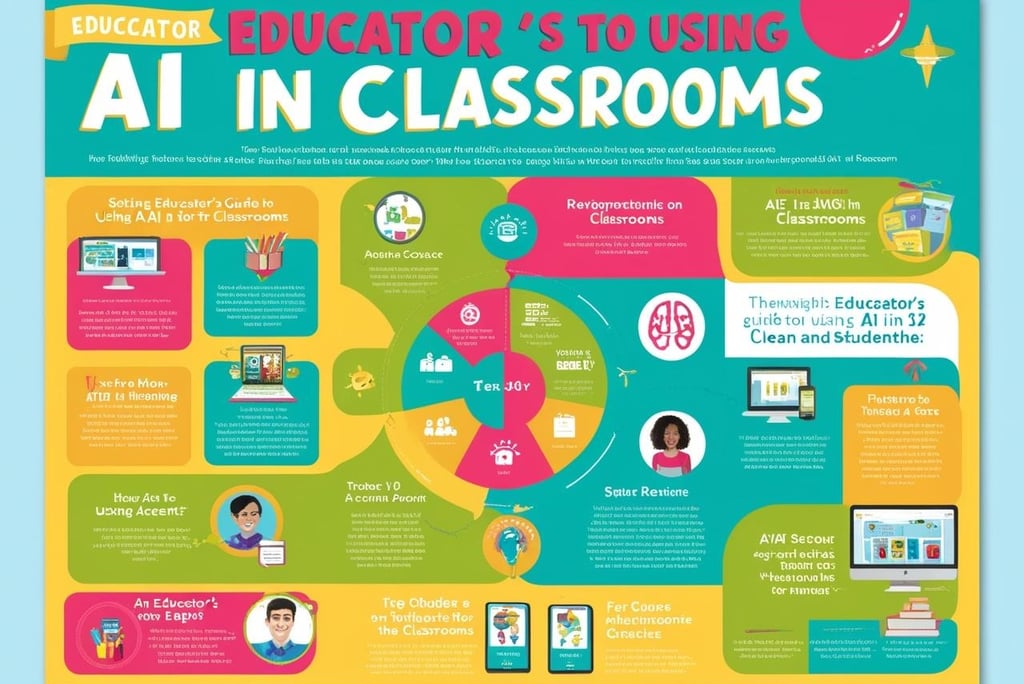An Educator’s Guide to Using AI in Classrooms
"Discover how educators can leverage AI in classrooms to enhance learning experiences. This guide covers AI tools, strategies, and best practices for integrating technology, helping teachers personalize education, improve student engagement, and foster innovative learning environments."
EDUCATION


Artificial intelligence (AI) is reshaping the education landscape, offering innovative ways to enhance learning experiences, streamline administrative tasks, and personalize student engagement. For educators, integrating AI into classrooms can seem daunting, but with the right approach, AI tools can transform teaching and learning.
This guide explores practical strategies, tools, and tips for using AI in classrooms, ensuring educators can harness its potential effectively.
Why Use AI in Classrooms?
1. Personalized Learning
AI enables tailored educational experiences by analyzing student performance and adapting to their unique needs. This ensures that every student progresses at their own pace.
2. Enhanced Engagement
Interactive AI tools like chatbots, virtual tutors, and gamified platforms make learning more engaging and enjoyable for students.
3. Efficient Administration
AI can automate tasks such as grading, attendance tracking, and scheduling, allowing teachers to focus more on instruction.
4. Data-Driven Insights
By analyzing large volumes of data, AI provides actionable insights into student performance, helping educators identify areas of improvement.
Getting Started with AI in Classrooms
A. Understand AI Basics
Before integrating AI into your teaching, familiarize yourself with the fundamentals of AI:
- Machine Learning (ML): Algorithms that allow systems to learn from data.
- Natural Language Processing (NLP): Technology enabling computers to understand human language.
- Computer Vision: Tools that interpret and analyze visual data.
B. Identify Classroom Needs
Determine the specific challenges or goals you aim to address with AI:
- Do you want to personalize learning?
- Are you looking to save time on administrative tasks?
- Do you need tools to boost student engagement?
C. Start Small
Begin with simple, user-friendly AI tools. Gradually scale up as you and your students become more comfortable.
AI Tools for Educators
1. Virtual Tutors and Chatbots
AI-powered virtual tutors provide real-time support to students, answering queries and reinforcing concepts outside of classroom hours.
Recommended Tools:
- ChatGPT: A versatile AI chatbot for answering student questions.
- Socratic by Google: Helps students understand complex topics with step-by-step explanations.
2. Adaptive Learning Platforms
These platforms analyze student performance and adjust content difficulty accordingly, ensuring optimal learning.
Recommended Tools:
- DreamBox Learning: Focuses on math skills with adaptive learning.
- Knewton: Provides personalized learning paths for various subjects.
3. AI for Grading and Assessment
Automate grading and provide detailed feedback using AI tools.
Recommended Tools:
- Gradescope: Simplifies grading and provides actionable analytics.
- Edmentum: Offers automated assessments and progress tracking.
4. Gamification and Engagement Tools
AI-powered gamified platforms increase student motivation and participation.
Recommended Tools:
- Kahoot!: Creates interactive quizzes and learning games.
- Quizlet: Uses AI to tailor flashcards and quizzes for better retention.
5. AI for Accessibility
AI tools help create an inclusive classroom environment for students with disabilities.
Recommended Tools:
- Microsoft Immersive Reader: Assists with reading comprehension.
- Otter.ai: Transcribes lessons in real-time for students with hearing impairments.
Integrating AI into Lesson Plans
A. Incorporate AI Tools Gradually
- Start by using one or two AI tools in a single lesson.
- Gather feedback from students and refine your approach.
B. Blend AI with Traditional Methods
AI should complement, not replace, traditional teaching methods. Use AI for specific tasks while maintaining face-to-face interaction for discussions and mentorship.
C. Encourage Collaboration
Promote group activities where students use AI tools to solve problems collaboratively, fostering teamwork and critical thinking.
Addressing Challenges in AI Adoption
1. Technical Challenges
- Ensure reliable internet connectivity and access to devices.
- Provide training for teachers to use AI tools effectively.
2. Data Privacy Concerns
- Choose AI tools that comply with data protection regulations like GDPR or FERPA.
- Educate students and parents about data usage policies.
3. Cost Constraints
- Leverage free or low-cost AI tools.
- Explore grants or funding opportunities to acquire advanced AI technologies.
4. Student Resistance
- Demonstrate the benefits of AI tools.
- Involve students in choosing and testing new technologies.
Professional Development for Educators
A. Online Courses
- Coursera’s AI for Everyone by Andrew Ng: A beginner-friendly introduction to AI.
- EdX’s Artificial Intelligence in Education: Explores the role of AI in modern classrooms.
B. Workshops and Webinars
Attend AI-focused events to stay updated on the latest tools and best practices.
C. AI Communities
Join forums and online communities to share experiences and learn from other educators.
Recommended Platforms:
- TeachAI.org: Resources for integrating AI into education.
- EdSurge: Insights and discussions on education technology trends.
AI Success Stories in Education
1. Personal learning success
- Case Study: A school in California implemented adaptive learning tools, resulting in a 30% improvement in math scores.
2. Streamlined Administrative Processes
- Case Study: A district in Texas used AI for scheduling and resource allocation, saving teachers 15 hours per week.
3. Enhanced Engagement through Gamification
- Case Study: An elementary school in the UK introduced AI-powered learning games, leading to higher attendance rates.
Future of AI in Education
As AI continues to evolve, its potential in education will expand:
- Intelligent Tutoring Systems: AI that mimics one-on-one tutoring.
- AI-Driven Content Creation: Tools that generate customized lesson plans and materials.
- Enhanced Emotional Intelligence: AI that recognizes and responds to student emotions to provide tailored support.
Conclusion
AI is a powerful ally for educators, capable of transforming classrooms into dynamic, personalized, and inclusive learning environments. By leveraging the right tools and strategies, educators can enhance their teaching effectiveness and prepare students for a tech-driven future.
Stay informed about the latest AI tools and trends in education at "Free Online AI Courses and Workshops in 2024".

